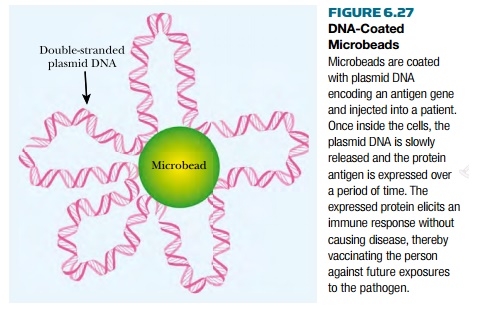Chapter: Biotechnology Applying the Genetic Revolution: Immune Technology
DNA Vaccines Bypass the Need to Purify Antigens
DNA
VACCINES BYPASS THE NEED TO PURIFY ANTIGENS
The principle of the DNA vaccine is to just administer DNA
that encodes appropriate antigens instead of providing whole microorganisms or
even purified proteins. Naked DNA vaccines consist of plasmids carrying the
gene for the antigen under control of a strong promoter. The intermediate early
promoter from cytomegalovirus is often used because of its strong expression.
The DNA is then injected directly into muscle tissue. The foreign genes are expressed
for a few weeks and the encoded protein is made in amounts sufficient to
trigger an immune response. The immune response is localized to the chosen
muscle, which helps avoid side effects. In addition, purified DNA is much
cheaper to prepare than purified protein and can be stored dry at room
temperature, avoiding the need for refrigeration. The best method of delivering
DNA is attaching it to a microparticle with a cationic surface (Fig. 6.27)
because the surface binds to the negatively charged phosphate backbone. After
the DNA-coated microparticle enters the cells, the DNA is slowly released from
the bead and is then converted into protein. The slow release of DNA elicits a
better immune response than a large direct dose of DNA. The immune system has
to create more and more antibodies to the proteins.

One problem with DNA vaccines
is that certain DNA sequences may induce an immune response directly. In
particular, some DNA sequence motifs found in bacterial DNA may elicit strong
immune responses, which in turn may cause the body to target its own DNA, thus
generating an autoimmune response.
Related Topics